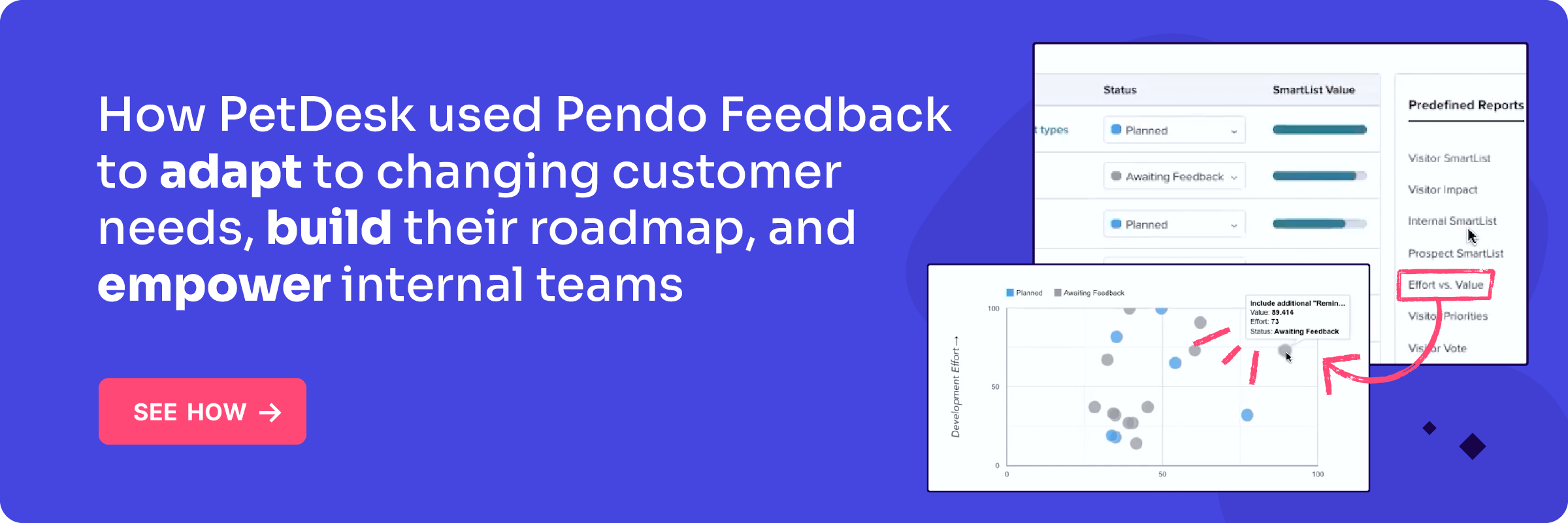Why it’s more important than ever for PM and CS to collaborate around feedback
The thought of introducing a customer feedback or voice of the customer (VoC) program to your organization may feel overwhelming. There’s the question of who will build it and run it, where the incoming feedback will be managed, and how all that information will ultimately impact the product. Plus there’s all that process to think through.
But as is the case with many seemingly daunting tasks, the hardest part is taking the first step. And with the right mindset and a collaborative approach, building a highly effective and scalable feedback engine doesn’t have to be scary (take it from these feedback pros).
More good news: You can take the very first step in setting up your feedback program right now—without any kind of implementation or tooling. All you have to have to do is help your product and customer success (CS) teams be friends.
In part one of our CS series, we talked about the key challenges that have historically prevented product and CS teams from collaborating at their best. Now, let’s look at why it’s more important than ever for these groups to work together, how a strong VoC program unites them (and improves the quality of their work), and why getting both teams on the same page should be stop number one on your organization’s feedback journey.
Customers expect a unified experience
In 2020, 85% of business buyers agreed that the experience a company provides is just as important as its products or services. And in the world of software as a service (SaaS), your product is your experience. That’s why it’s important to rally all the teams within your organization around the product and put it at the center of your customers’ experience (we call this being product led).
A powerful first step towards unifying your entire customer experience (CX) is building cohesion between the team building the product and the team helping customers use it to its fullest potential.
Misalignment between product and CS manifests in a number of ways. Early in the customer journey, it could look like inconsistent (and at worst, deal-killing) positioning—a consequence of both teams not getting on the same page about the product’s features, functionality, and differentiators. It could also lead to painful or awkward conversations between customers and customer success managers (CSMs), who can’t confidently speak to the product roadmap or reassure their customers of what’s on the horizon. Even more importantly, misalignment between product and CS negatively impacts the software development and adoption process itself—resulting in features that don’t actually solve customer problems and thus go left unused.
Conversely, when product and CS teams rally around customer feedback, they work from a shared understanding of the customer experience—and are thus more empowered to impact it positively. Alignment between product and CS helps both address customer pain points in a holistic way. The product becomes stronger when user behaviors and customer needs inform its development. CSMs have richer discussions with their customers because they better understand the product, know the roadmap, and can confidently explain why particular initiatives are being addressed (or not). And customers gain confidence in the brand—and become more likely to renew—as their product experience improves.
A single source of truth mitigates duplicity
Particularly in enterprise organizations, bringing product and CS together around a single source of customer feedback truth helps ensure you don’t duplicate costly or resource-intensive efforts across various parts of your business.
When every PM and CSM has his or her own way of keeping track of customer requests (including possibly not keeping track of them at all), there’s no way to evaluate your customers’ feedback in aggregate. This makes it impossible to identify trends and make informed decisions about how to address them. It also often leads to feedback getting lost in a black hole, or results in teams working in silos that only partially solve micro-level customer challenges that could be more effectively addressed by cross-functional efforts.
A disconnected feedback approach impacts how much your customers trust your organization, too. 80% of business buyers said they expect consistent interactions across the various groups they work with throughout the buying process, but 60% reported feeling as though they’re communicating with separate entities, not a single company. This experience gap erodes buyer and customer confidence, and is only exacerbated by duplicative, inconsistent, or contradictory communications sent from teams across the organization. Getting product and CS on the same page about what your customers think and feel ensures you communicate a clear message—so you can speak with a unified voice and strengthen your credibility.
Teams want to share their strengths
A shared customer feedback process has a powerful impact on your people (which certainly doesn’t hurt amidst the Great Resignation). In addition to helping your PMs and CSMs become more effective in their individual roles, rallying around a joint and scalable customer feedback program helps both product and CS feel valued, expands the potential impact of their work, and (with the right tool) ultimately frees them up to focus on higher-order tasks.
For product, partnering with CS allows you to stay close to your customers—a feat that becomes increasingly difficult as your organization grows and scales—so you can better understand their challenges and build solutions to suit. Working with CSMs also improves the quality of the feedback data PMs have to work with. Feedback submitted directly by customers often lacks context, and may not be informed by initiatives already on (or intentionally not on) the roadmap. CSMs can help PMs fill in the gaps and get to the full story behind customer requests, which results in stronger products and more effective features.
For CS, getting closer to the product is hugely empowering. It helps CSMs feel confident in their knowledge of the product so they can have more fruitful conversations with their customers. It helps them feel included and valued in the product-led development process (which can sometimes feel like a blackbox for non-product teams). And it helps them help their customers and keep them happy—which ultimately opens the door for easier renewal and expansion discussions.
How to get started
Here are a few simple steps to help you start unifying product and CS around a shared feedback motion:
- Get the right people in the room
Identify your organization’s customer feedback champions—including CSMs, CX leaders, PMs, and product operations—and bring them together to have a conversation about the current state of your feedback collection process. - Take stock of what you’ve got
Audit all the ways various teams across your organization are currently capturing customer feedback. What’s working well? What’s not? - Pick one place for customer feedback
Choose a single location for intaking and triaging customer feedback. And make sure everyone across your organization can access it so they’re all working from the same source of truth. - Check in regularly
Set up a recurring meeting to bring together your feedback champions, CS teams, and product leaders, and consider creating a forum where key findings and insights can be shared with the broader organization. This is also a great opportunity for CS and product to share learnings from their most recent interactions with customers or talk about upcoming initiatives in the product.
In part three of this series, we’ll explore strategies to help product and CS teams get the most value possible from customer feedback, and look at a few scenarios where better feedback-driven collaboration can lead to better customer experiences.



